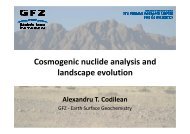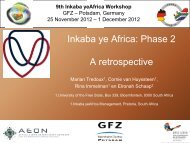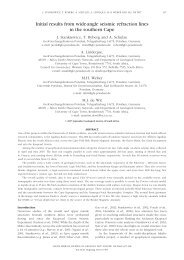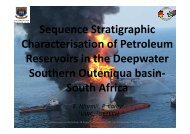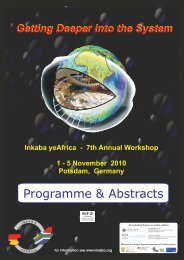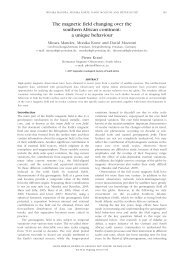South Africa - Inkaba.org
South Africa - Inkaba.org
South Africa - Inkaba.org
Create successful ePaper yourself
Turn your PDF publications into a flip-book with our unique Google optimized e-Paper software.
Observational studies to mitigate seismic risks in mines:<br />
a new Japanese - <strong>South</strong> <strong>Africa</strong>n collaborative research project<br />
R J Durrheim 1,3,4 , H Ogasawara 1,2 , M Nakatani 1,5 , Y Yabe 1,6 , A Milev 1,4 , A Cichowicz 1,7 , H<br />
Kawakata 1,2 , H Moriya 1,6 and the SATREPS 1 research group<br />
1 JST-JICA Science and Technology Research Partnership for Sustainable Development<br />
2 Ritsumeikan University, Japan<br />
3 University of the Witwatersrand, <strong>South</strong> <strong>Africa</strong><br />
4 Council for Scientific and Industrial Research, <strong>South</strong> <strong>Africa</strong><br />
5 Earthquake Research Institute of the University of Tokyo, Japan<br />
6 Tohoku University, Japan<br />
7 Council for Geoscience, <strong>South</strong> <strong>Africa</strong><br />
ABSTRACT<br />
Mining-induced earthquakes pose a risk to workers in deep <strong>South</strong> <strong>Africa</strong>n mines, while natural earthquakes pose a<br />
risk to people living close to plate boundaries. We introduce a 5-year Japanese - <strong>South</strong> <strong>Africa</strong>n collaborative<br />
project entitled "Observational studies to mitigate seismic risks in mines" that commenced in 2010. The project,<br />
which seeks to develop human and instrumental capacity in <strong>South</strong> <strong>Africa</strong>, will build on previous studies carried out<br />
by Japanese and <strong>South</strong> <strong>Africa</strong>n seismologists in deep gold mines. Some aspects of the study will also cast light on<br />
the mechanisms that generate tectonic earthquakes.<br />
The project has five major work streams:<br />
1. Determination of rock properties. We intend to map the rock mass and collect rock samples to probe mechanical<br />
properties in both the impending seismic sources and surrounding host rock. Measurements of basic parameters<br />
(elastic constants, fracture strength and elastic wave velocities) will be made in both <strong>South</strong> <strong>Africa</strong> and Japan,<br />
while more advanced experiments (temporal changes in the micro-fracturing activity and the physical properties<br />
during fracture process) will be conducted in Japan.<br />
2. Sensitive close monitoring. We seek to investigate the preparation processes preceding earthquakes, and<br />
especially the occurrence of forerunners. However, quasi-static stress changes and high-frequency seismic<br />
waves decay very rapidly with distance. Consequently, arrays of instruments designed to monitor subtle change<br />
associated with preparation of earthquakes must be installed as close as possible to the likely source region.<br />
3. Seismic hazard assessment methods. We will rigorously test seismic hazard assessment methods currently used<br />
in <strong>South</strong> <strong>Africa</strong>n mines. We will also apply the stress inversion method that was recently used by Japanese<br />
seismologists to delineate the fine detail of stress distribution<br />
4. Strong ground motion monitoring. The evolution of fault rupture has not yet been monitored in situ at scales<br />
greater than the centimetre dimension of a laboratory rock sample. Consequently, it is not known how rupture<br />
evolves or how strong ground motion is generated in great tectonic earthquakes. In order to improve mine<br />
design strategies and the effectiveness of support elements and systems, we have to clarify the geometrical<br />
attenuation of strong motion and the site amplification factor at the stope.<br />
5. Upgrading of the <strong>South</strong> <strong>Africa</strong>n National Seismological Network (SANSN) in the mining districts. Large<br />
earthquakes (M>4.0) occur several times a year in mining districts and sometimes cause damage to surface<br />
structures. However, these important earthquakes are inadequately recorded by either the sparse SANSN or<br />
mine networks that are equipped with short period geophones. This limits an accurate evaluation of the faulting<br />
process of such big earthquakes.<br />
A program of exploratory drilling began in 2010 to delineate the fault zones that the mining face will approach in<br />
2012-2013. Additional holes will be drilled in 2011 to install sensors.<br />
KEYWORDS: seismic hazard, mine seismology, rockbursts, deep gold mines<br />
24



